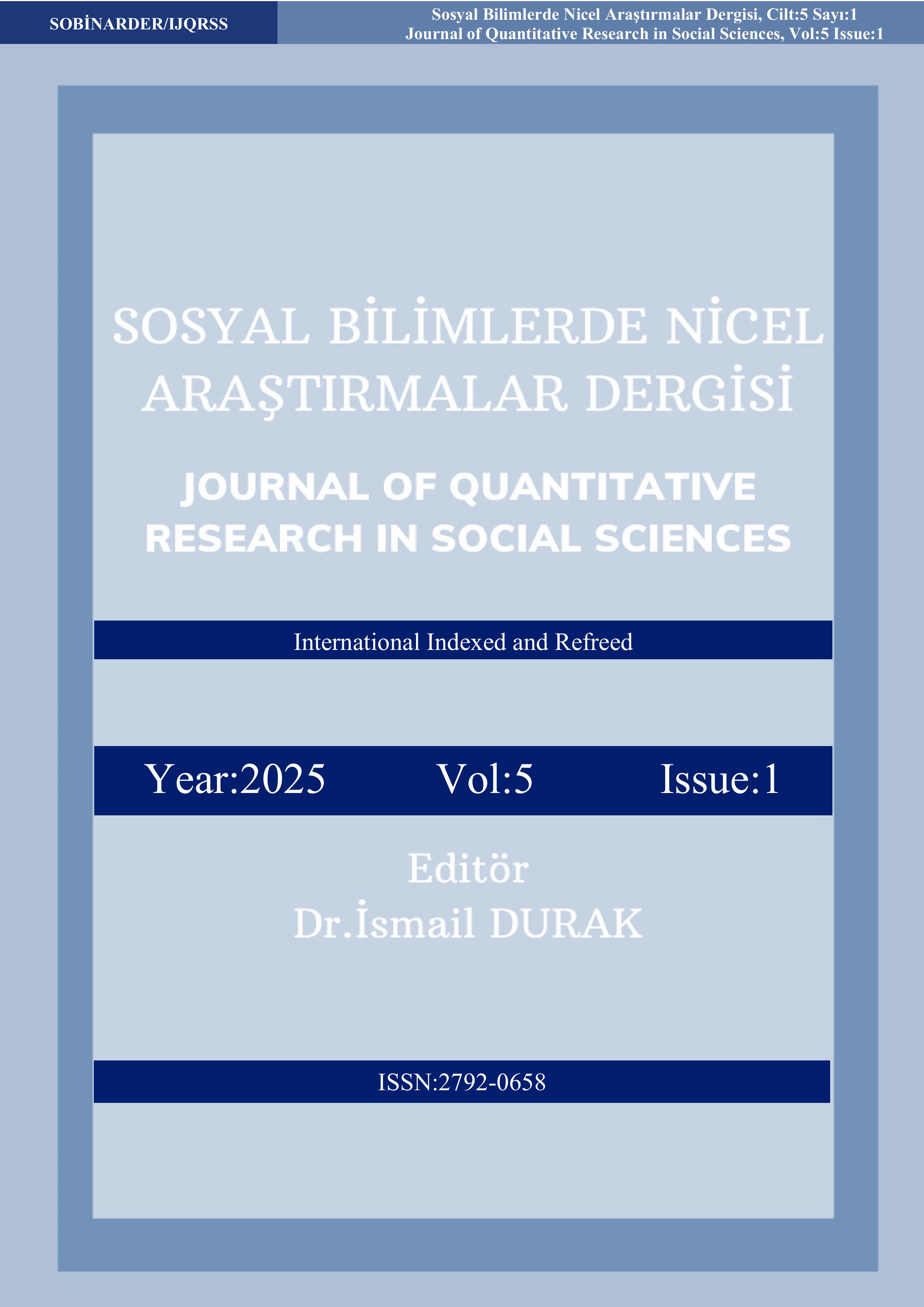Forecasting Traffic Accident Numbers Using Time Series Models
Zaman Serisi Modelleri ile Trafik Kazası Sayılarının Tahmin Edilmesi
Keywords:
Time Series Models, Traffic Accident Numbers, ARIMA ModelAbstract
This study aims to forecast the number of traffic accidents that may occur in the jurisdiction of the Gendarmerie in the Western Black Sea Region using time series models. Statistical data from April 2019 to December 2023 obtained from the official website of the General Command of Gendarmerie have been utilized. This data includes traffic accidents occurring in the provinces of Bartın, Bolu, Düzce, Karabük, Kastamonu, Sinop, and Zonguldak. The Autoregressive Integrated Moving Average (ARIMA) method has been employed to predict future accident numbers. In this context, data analyses and modeling have been conducted using Minitab and EViews software. The results of the study are supported by trend analysis, seasonality analysis, and forecasting models. According to the findings, predicting the number of traffic accidents will contribute to more informed and effective decision-making by managers in personnel allocation and economic planning. Furthermore, the forecast results obtained will assist in taking necessary measures to prevent traffic accidents, which are significant for public health and the state economy, in future similar studies relevant to academic and public institutions.
References
Akdur, R. (2012). Türkiye’deki trafik kazalarının epidemiyolojik ilkeler ışığında değerlendirilmesi. Ulaşım ve Trafik Güvenliği Dergisi, S, 1-17.
Aksoy, M., Bertan, B., & Kara, E. (2025). YÖK Tez Veri Tabanında Yer Alan Güvenlik Performansı Konulu Tezlerin Analizi: Meta Bir Değerlendirme. Fırat Üniversitesi Uluslararası İktisadi ve İdari Bilimler Dergisi, 9(1), 27-42.
Andreassen, D. C. (1985). Linking deaths with vehicles and population. Traffic Engineering and Control, 26(11), 547-549.
Atalay, A., Tortum, A., & Gökdağ, M. (2012). Türkiye’de 1977-2006 yılları arasında meydana gelen aylık trafik kazalarının zamansal analizi. Pamukkale University Journal of Engineering Sciences, 18(3), 221-229.
Box, G. E. P., & Jenkins, G. M. (1976). Time Series Analysis: Forecasting and Control. Revised Edition, Holden Day, San Francisco.
Brockwell, P. J., & Davis, R. A. (2002). Introduction to time series and forecasting (2nd ed). Springer, New York.
Brooks, C. (2008). Introductory econometrics for finance (2nd ed). Cambridge University Press. Cambridge.
Chatfield, C. (2016). The Analysis of Time Series: An Introduction, Sixth Edition. İçinde The Analysis of Time Series: An Introduction, Sixth Edition (s. 329). Chapman and hall/CRC.
Dickey, D. A., & Fuller, W. A. (1979). Distribution of the estimators for autoregressive time series with a unit root. Journal of the American Statistical Association, 74(366), 427-431.
Eken, Ö. F. (2025). Asya, Avrupa, Amerika’daki Akıllı Kent Modellerinin Türkiye’deki Kentler Bağlamında Karşılaştırmalı Tasarım Analizi.
Enders, W. (2015). Applied econometric time series (Fourth edition.). Hoboken, NJ: Wiley.
Erbey, A. (2025). Akıllı Şehirlerde Teknoloji ve Veri Yönetimi: Geleceğin Şehir Yaşamı. Yönetim Bilişim Sistemleri Alanında Yenilikçi Çözümler ve Güncel Yaklaşımlar, 69.
Erdogan, S., Yilmaz, I., Baybura, T., & Gullu, M. (2008). Geographical information systems aided traffic accident analysis system case study: City of Afyonkarahisar. Accident Analysis & Prevention, 40(1), 174-181.
Fuller, W. A. (1976). Introduction to statistical time series (2nd.ed). John Wiley & Sons.
Gündüz, G., & Yüksel, İ. (2020). İç Güvenlik Yönetiminde Uygulanan Modeller; Türkiye ve ABD’nin İç Güvenlik Yönetim Uygulamalarına Yönelik Bir Araştırma. International Journal of Social and Humanities Sciences Research (JSHSR), 7(60), 2915-2924.
Haavelmo, T. (1944). The probability approach in econometrics. Econometrica, 12, iii-115.
Hamilton, J. D. (1994). Time series analysis. Princeton, N.J: Princeton University Press.
Hyndman, R. J., & Athanasopoulos, G. (2018). Forecasting: Principles and practice. OTexts.
Karaa, I. B., Khoufi, I., Shatnawi, O., & Ghedira, K. (2018). Prediction and analysis of road accidents in Tunisia. In 2018 IEEE/ACS 15th International Conference on Computer Systems and Applications (AICCSA) (pp. 1-6). IEEE.
Kaygısız, Ö., Senbil, M., & Yıldız, A. (2017). Influence of urban built environment on traffic accidents: The case of Eskisehir (Turkey). Case Studies on Transport Policy, 5(2), 306-313.
Khisty, C. J., & Ayvalik, C. (2002). And Fatality Rates in Illinois.
Kumar, S., & Toshniwal, D. (2016). A data mining approach to characterize road accident locations. Journal of Modern Transportation, 24(1), 62-72.
Mohan, D. (2002). Social cost of road traffic crashes in India. İçinde Proceedings First Safe Community Conference on Cost of Injury (pp. 33-38). Viborg: Safe Community Conference on Cost of Injury.
Özoğlu, B., & Demi̇rci̇, S. B. (2021). Türkiye’de karayolu taşımacılığının değerlendirilmesi: Bir literatür taraması. Ömer Halisdemir Üniversitesi İktisadi ve İdari Bilimler Fakültesi Dergisi, 14(2), 670-687.
Öztaş Karlı, R. G. (2025). Akıllı kent donatılarının ulaşım sistemlerindeki rolü ve etkileri. Journal of Intelligent Transportation Systems & Applications, 8(1).
Pindyck, R. S., & Rubinfeld, D. L. (1991). Econometric Models and Economic Forecasts.McGraw-Hill.
Shin, Y., Kwiatkowski, D., Schmidt, P., & Phillips, P. C. B. (1992). Testing the null hypothesis of stationarity against the alternative of a unit root: How sure are we that economic time series are nonstationary? Journal of Econometrics, 54(1-3), 159-178.
Shumway, R. H., & Stoffer, D. S. (2011). Time Series Analysis and Its Applications. Springer, New York.
Smeed, R. J. (1949). Some statistical aspects of road safety research. Journal of the Royal Statistical Society. Series A (General), 112(1), 1-34.
TÜİK. (2022). Türkiye İstatistik Kurumu. https://data.tuik.gov.tr/Bulten/Index?p=Karayolu-Trafik-Kaza-Istatistikleri-2021-45658 (Erişim Tarihi: 2023, Şubat 26)
World Health Organization. (2018). Global status report on road safety 2018. World Health Organization.
Xie, Y., Lord, D., & Zhang, Y. (2007). Predicting motor vehicle collisions using Bayesian neural network models: An empirical analysis. Accident Analysis & Prevention, 39(5), 922-933.
Yenipınar, F. (2024). Trafik Kazalarının Neden ve Etkileri Üzerine Küresel Önlemler Analizi. Recep Tayyip Erdoğan Üniversitesi Sosyal Bilimler Dergisi, 11(2), 140-151.
Yu, R., Xiong, Y., & Abdel-Aty, M. (2015). A correlated random parameter approach to investigate the effects of weather conditions on crash risk for a mountainous freeway. Transportation Research Part C: Emerging Technologies, 50, 68-77.
Yule, G. U. (1926). Why do we Sometimes get Nonsense-Correlations between Time-Series: A Study in Sampling and the Nature of Time-Series. Journal of the Royal Statistical Society, 89(1), 1. doi:10.2307/234148f.
Sayılı Karayolları Trafik Kanunu (1983). T.C. Resmî Gazete,18195, 18 Ekim 1983
Downloads
Published
How to Cite
Issue
Section
License
Copyright (c) 2025 Journal of Quantitative Research in Social Sciences

This work is licensed under a Creative Commons Attribution-NonCommercial 4.0 International License.
Telif hakkı hakkında










